Eggs are known to be a generous protein source. It is recommended to include eggs in your diet from childhood. There are a number of ways to consume eggs, but boiled eggs are one of the yummiest form of eggs. Today, you’ll learn how to boil eggs so that you can enjoy this easy snack in your breakfast, as a side in your lunch or as a midnight healthy snack.
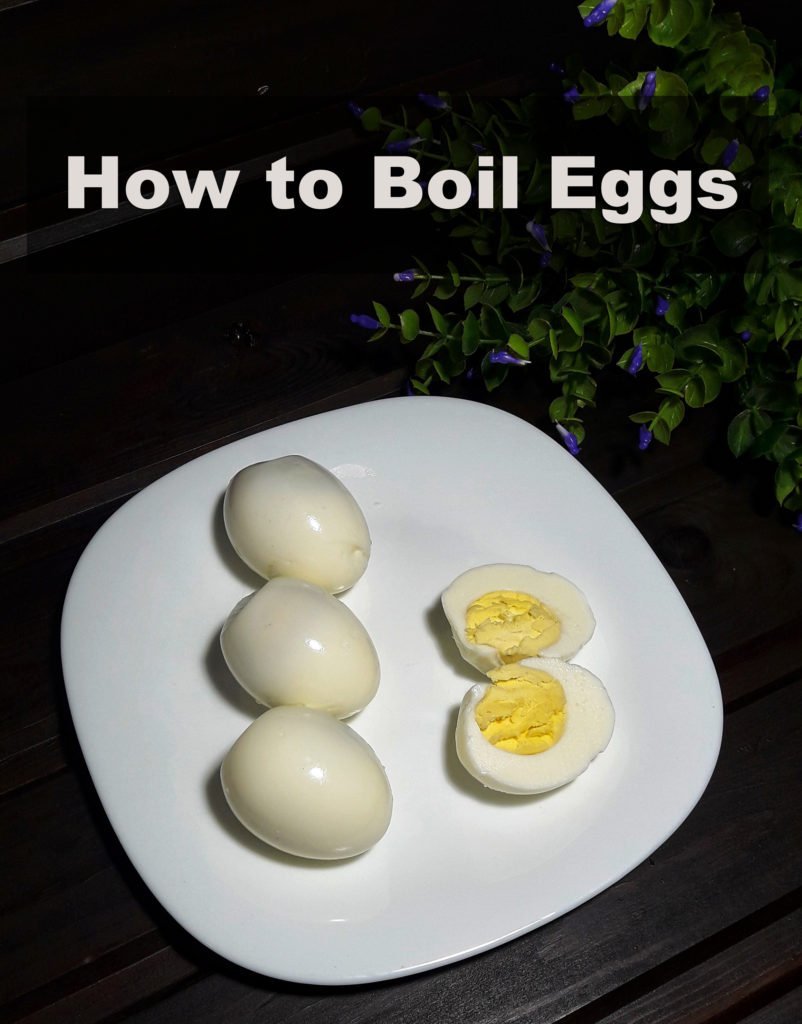
Contents
How to boil eggs (Step-by-Step Instructions)
The market has a variety of types of eggs available. Not only do you get different animals’ eggs, but you also have further specifications such as organic. Chicken eggs are the most commonly used ones so that’s what we’re focusing on today. However, you can always go for the ones that you like the best. Once you have evenly-sized eggs, it’s time to start boiling them.
Our process of boiling eggs is a little different. You may be wondering who wouldn’t know how to boil eggs, but the truth is that there are definitely some tips you can follow to get the best results.
Step 1: take a pan
To start the process, you’ll need an appropriate pan. There are a fair few specifications that are required here. First of all, it should be wide and tall enough to hold the eggs and water. We’ll be using 4 eggs in today’s demonstration so we’ve opted for a pan that can hold 4 eggs side by side, without any one egg laying over the other. This stacking can prevent the eggs from getting cooked evenly. Moreover, the pan is big enough to hold the eggs along with plenty of water. Even when the water boils, there is no risk of it overflowing from the top.
The next thing is that your pan must have a lid. It is necessary to cover the pan in further steps. You can always use any heat resistant plate to cover the pan if it doesn’t have a lid.
Lastly, the pan should have a wooden handle. Some pans have metallic handles or none at all. The requirement of handles is important so that you can lift the pan and drain the water later on. Wooden handles are the best because they don’t heat up. Such pans make the safest option.
Step 2: choose eggs
Now, you’ll be adding the eggs in the chosen pan. Choose your eggs wisely. As previously mentioned, you’ll find a wide variety in the market. You have the complete freedom to choose whichever ones you want. However, pick the 4 eggs that seem to be of the same size and are of the same type, for example choose 4 organic chicken eggs that are almost all of the same size. This ensures the even cooking of all the eggs.
Next, clean the eggs using a paper towel. You can go a further step by washing them too. However, that isn’t really necessary because you’re going to be peeling the shell anyway. It is just a precautionary step that some people don’t mind.
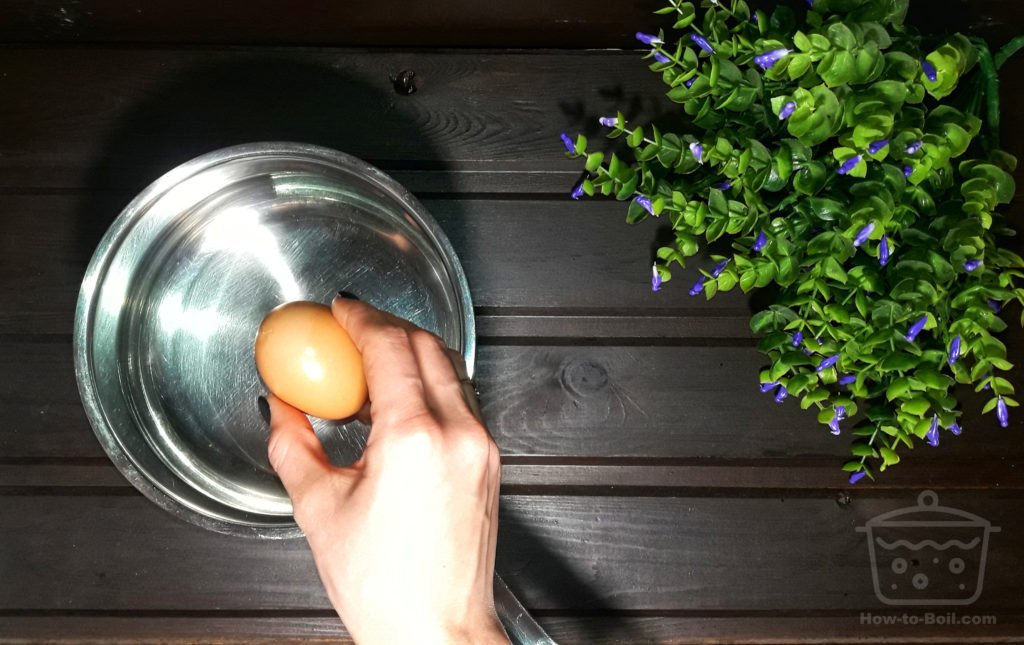
Step 3: add water
After that, you will add water to the pan. There is no specific amount of water. It varies depending on the size of your pan. The general rule is to fill the pan enough that all the eggs are covered in water. Moreover, the level of water should be 1 inch higher than the eggs. Having the eggs covered in water allows the uniform distribution of heat throughout the pan. This is why using the right amount of water is crucial in the process of how to boil eggs.
Step 4: add salt
You are now going to add a teaspoon of salt in the water. Mix it well. When you talk of the process of how to boil eggs, the issue isn’t cooking the eggs. The problem is preventing the shell from cracking halfway between the process. Salt is added to eliminate this issue. You can also use vinegar as an alternative to salt. Moreover, they help the egg white harden even if it leaks. This won’t ruin or waste your egg despite any leaks.
Furthermore, adding salt helps increase water temperature. Boiling water usually gets to 100 degrees Celsius temperature. By adding salt, this temperature can rise further, allowing the egg to cook faster.
Step 5: boil the water
Now the preparations are done, it’s time to start boiling the water. Cover the lid of the pan and keep the heat setting of the stove at the highest level. Let the water boil. Once the water starts boiling, start a timer. Keep the heat on for exactly 3 minutes. Make sure that the water keeps boiling during these 3 minutes. Do not lower the temperature or uncover the pan. This can cause loss of heat and the final result may not be perfect if this is done.
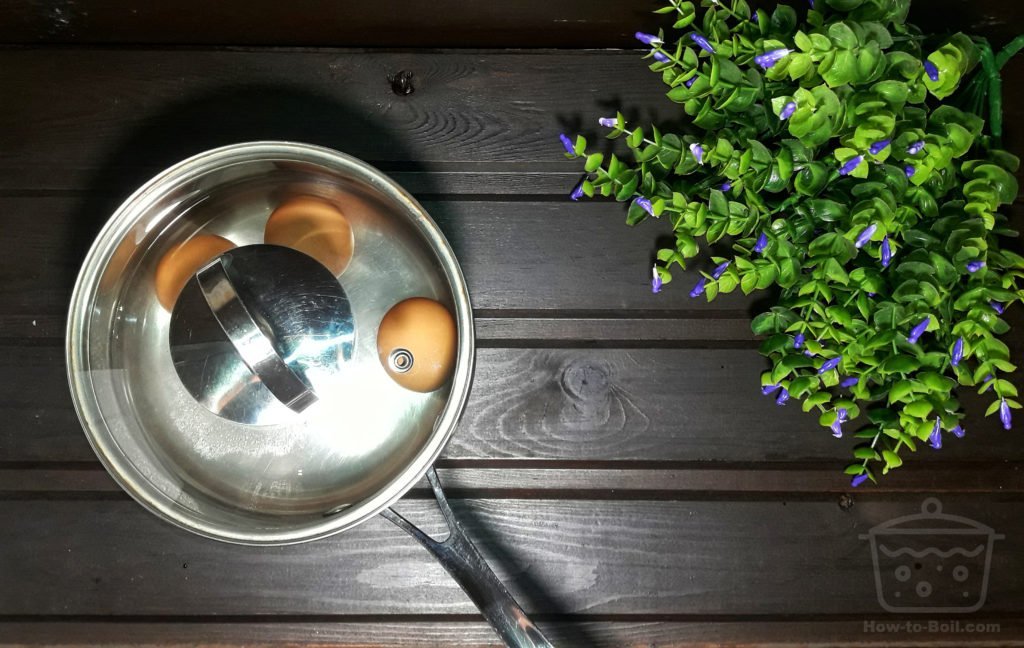
Step 6: cook
The next step is to let the eggs cook. After the 3 minutes of boiling, you should remove the pan from the stove. Do not uncover the pan. As previously mentioned, taking the lid off will cause loss temperature and the eggs may remain uncooked. Leave the pan untouched for a further 10 minutes. The heat of the water will be enough to prepare the final eggs. This step will also make the next step safer.
Step 7: drain the water
Since the water has been off the flames for 10 minutes, it won’t be as hot now. Therefore, you can safely carry the pan to the sink now. Carefully drain all the water but keep the eggs in the same pan. Make sure to use oven gloves to prevent the heat from damaging your hands. Also, be extra careful when draining the water to stay safe from hot water splashes. When you first uncover the pan, expect a lot of steam. Keep your face and hands away from the top of the pan at this point or you could end up with severe burns.
Step 8: add cold water
You’ll now have a pan with 4 eggs. The next step is to add cold water in this pan. Once again, the water level should be one inch higher than the surface of the eggs. This step will lower the temperature of the eggs so the peeling process will become easier. Similarly, the cold water will harden the shell. Boiled egg shells tend to stick to the protein in the egg whites. This step will solve this problem and make peeling a very neat process.
How long to boil eggs
In the case of boiled eggs, you can alter the final product by cooking it for different time periods. This table summarizes the boiling time along with the softness of the egg.
| Cooking time | State of egg whites | State of egg yolk |
|---|---|---|
| 2-3 minutes | Partially cooked | Raw |
| 5-7 minutes | Custard-like consistency | Solidified but partially uncooked |
| 9-11 minutes | Solidified | Partially cooked, soft center |
| 13-15 minutes | Fully cooked | Fully cooked |
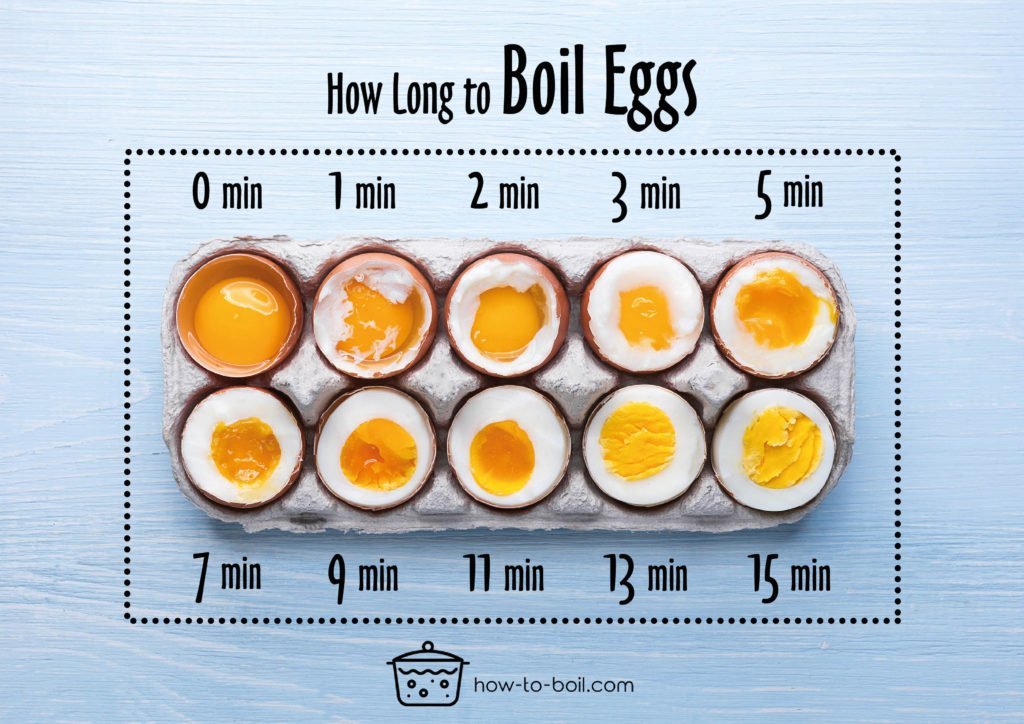
As you can see, the eggs go from raw to soft boil in the first 5 minutes. The next 10 minutes harden the yolk further, resulting in a hard-boiled egg.
These cooking times aren’t restricted to the boiling stage only. In fact, in some cases, the post boiling cooking time is also added. The process and technique vary. Don’t expect the stated results by simply cooking eggs in boiling water for the mentioned time period. Following are detailed instructions on how to boil eggs for the perfect consistency.
How to hard boil eggs
A fully cooked egg is called a hard-boiled egg. The egg white, as well as the yolk, is solidified. Getting the perfect hard boiled egg isn’t easy. You’ll need to be precise or else either the egg will remain uncooked or it will become too hard due to overcooking. These steps will teach you how to boil eggs to get a fully cooked final product. The process is pretty much the same but there are a fair few specifications to take care of.
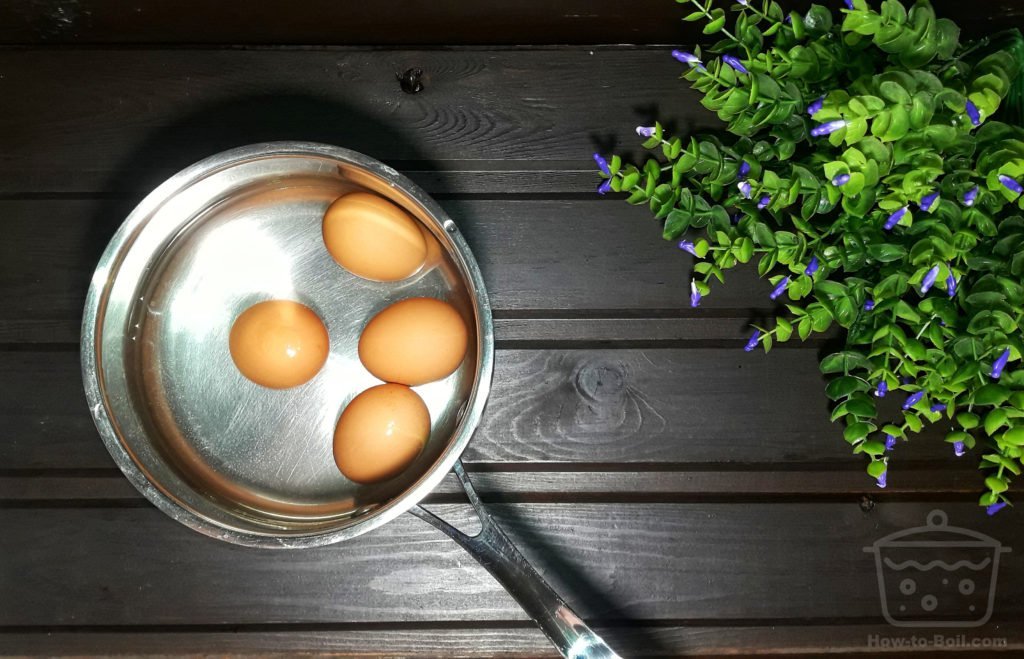
Step 1: prep
The first step is to prepare for the final product. Even before you put a pan on the flames, you need to grab a bowl. Fill it up with ice cold water. You’ll find out why later on!
Step 2: put the eggs in a pan
Just like the regular egg boiling, hard boiling eggs requires you to put in the eggs before adding the water. The pan specifications are similar too.
Step 3: add water
The next step is to cover the eggs in the pan with water. Once again, they should be at least 1-inch deep in the water to allow for uniform cooking.
Step 4: salt or vinegar
Adding 1 tsp salt or vinegar in water is a must in case of hard-boiled eggs. Since the cooking time is longer, the eggs are more likely to crack. Salt and vinegar both prevent this. Moreover, these act as agents that help the increase the boiling temperature of water. This is yet another important requirement for hard boiling eggs.
Step 5: boil the eggs
Now, add the eggs in your boiling water. Cover the pan with its lid. Let the water boil for another 3-5 minutes, depending on how hard you want the egg to be. Then, turn off the flames. Do not boil for over 5 minutes or else you’ll end up with an overcooked egg.
Step 6: cook the eggs
Let the eggs sit in the hot water for another 10 minutes.
Step 7: put them in ice water
Immediately after removing the eggs from the hot water, put them in the ice water you prepared previously. This will prevent the eggshell from sticking with the egg whites and will aid the process of peeling.
Step 8: peel and serve
Voila! Peel off the eggshells and your hard boiled eggs are ready to be devoured!
How to soft boil eggs
If you want to learn how to boil eggs with a runny yolk, this is the right place to learn everything you need to know. Soft boil eggs have a cooked egg white but the yolk remains raw. The egg whites also have a custard-like texture. Overall, soft boiled eggs are neither fully solidified nor liquid. Timing is vital in this scenario.
Step 1: choose a pan
As with regular boiling, a soft boil egg needs to be prepared in the right sized pan. It should be a good heat conductor so that uniform heat is maintained inside the pan. Moreover, the eggs shouldn’t be stacked.
Step 2: add water
Unlike regular boiling, soft boil eggs require the addition of water before putting the eggs in. You’ll have to be cautious with the amount of water you add in. Estimate how high your eggs will be and approximately add water that will cover the eggs entirely.

Step 3: bring it to boil
Turn the stove on the highest flame setting. Cover the pan with a lid and let the water come to its boiling point.
Step 4: add eggs
After the water has started boiling, lower the flames. The water will then start to continuously simmer. This is the stage when you have to add the eggs. You should be very careful – boiling water’s steam can cause burns. Similarly, eggs should be added cautiously too. Do not throw the eggs in or the hot water splashes can hurt you. Also, don’t get your hand too close to the water level when putting the eggs in as that increases the risk of getting the finger dipped in the hot water. You can use something like a tong to safely place the eggs in the pan.
Step 5: start the timer
Start the count of time immediately after the eggs are in the water. Don’t just estimate the time – use a timer since it is a game of seconds that can change your soft boil egg to a hard boil egg. Preset a timer for 5 minutes and turn it on as soon as the eggs land in the water. This is for when you want very runny yolks. If you like something slightly hardened that can still be eaten with a spoon, extend the time to 7 minutes.
Step 6: pour cold water
Now, your egg will be at the perfect stage. However, a few more seconds of heat can ruin that. In order to prevent that from happening, remove the eggs from the hot pan immediately. Drain the hot water carefully. Preferably, pull out the eggs from the pan. This will be quicker and will also prevent the heat of the pan itself from transferring into the eggs.
That’s not all. The egg itself will be warm enough to continue cooking. To tackle this, you need to add cold water in the pan holding the eggs. An alternative is to hold the eggs under cold running water.
Step 7: serve
Your soft boil eggs are now ready. Crack them open and serve in an egg cup!
How to peel boiled eggs
These tips are tried and tested for making egg peeling easier.
- Never forget to add salt or vinegar in the boiling water.
- If salt and vinegar are failing you, add a tsp of baking soda.
- Use old eggs. 10-12 days old eggs are usually perfect.
- Never skip the last step which is to add the eggs in cold water. It will harden the eggshell and make it easier for you to pull it off.
- First, crack the entire shell and then start peeling.
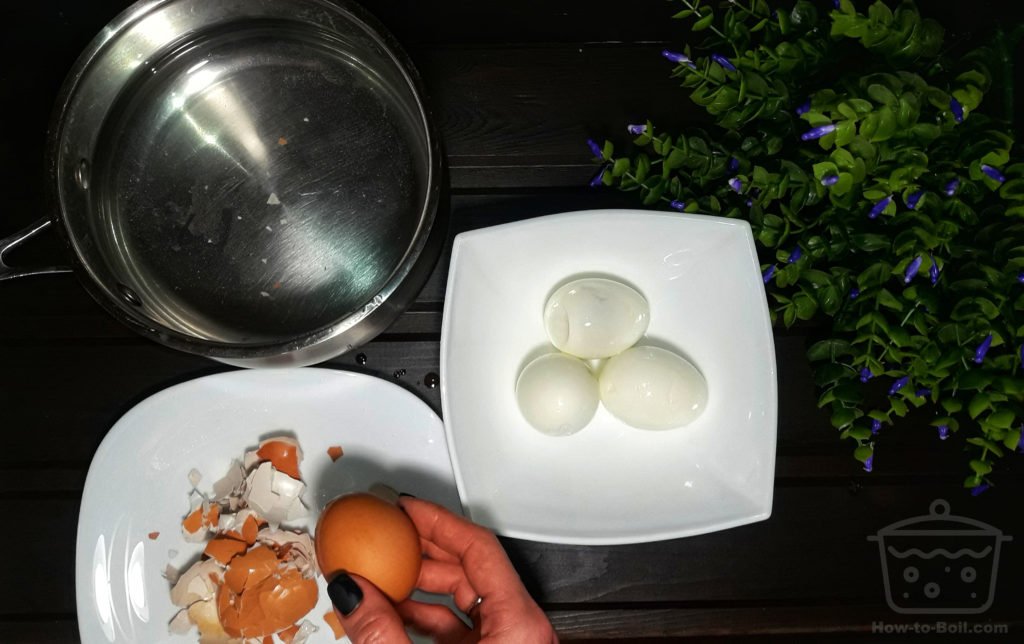
How to store boiled eggs
If you plan on keeping the eggs for a couple of days, you can store peeled eggs without a worry. Soft and hard boiled eggs both can be stored for up to 3 days easily. However, if you’re not going to be consuming the eggs within a couple of days, it’s best not to peel them. Generally, it is recommended not to keep the boiled eggs, whether peeled or not, for more than a week.
Always store the eggs in the refrigerator. But, do not keep them in the door. Since the door is opened frequently, it has a varying temperature. Cooked eggs must always be kept in the main part of the fridge.
Nutritional information for hard-boiled eggs
Eggs, in general, are known to be generous protein sources, as chicken for your information. Hard-boiled eggs offer a balanced nutritional value. The following facts are for 100g of hard-boiled egg.
You’ll find 373mg of cholesterol in 100g of hard boil eggs. Other than that, there is a total of 11g of fats. Out of these, 3.3g are saturated, 1.4g are unsaturated, and 4.1g are monounsaturated. 124mg of sodium and 126mg of potassium are also part of 100g hard boiled eggs. There are 1.1g carbohydrates which are all sugar. There is 0% fiber. Other than 13g of protein, you’ll also get plenty of Vitamin A, Calcium, Iron, Magnesium, Vitamin D, Vitamin B-6, and Cobalamin.
Frequently Asked Questions
- The eggs crack as soon as I put them in boiling water, what am I doing wrong?
You’re probably adding cold eggs into extremely hot water. If you’re using eggs that were placed in the refrigerator, put them out at least 15 minutes before boiling. This will bring them to room temperature. Moreover, try lowering the heat. Add the eggs in when the water is simmering. The eggs won’t bounce around and there will be a lower chance that they’ll crack.
- I wanted a hard boil egg but it wasn’t fully cooked. Now I’ve peeled it. What should I do?
You can’t put the egg back in the boiling water. It would cause the egg to burst open. Simply enjoy poached eggs instead of hard boiled ones for the moment.
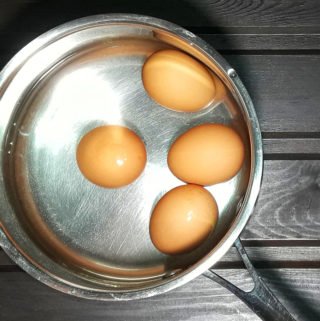
How to Boil Eggs (Hard Boil, Soft Boil)
Equipment
- Pan
- Tablespoon
Ingredients
- 4 PCs chicken eggs
- 1 tsp salt
- Water
Instructions
- Take a pan
- Choose eggs
- Add water
- Add salt
- Boil the water
- Cook
- Drain the water
- Add cold water
Notes
Useful tips
Beginners can be intimidated by the simplest things too. We have already solved most queries that may come to one's mind when thinking of how to boil eggs. However, here are a few more tips that will help you in the kitchen.- If you’re boiling one egg, bring down the boiling time from 3 minutes to 2 minutes. For the soft boil method, bring it down from 5 minutes to 4 minutes.
- Never boil more than 4 eggs at once. Batches of 4 will allow quick and efficient cooking.
- Never start cooking an egg in cold water if you want a soft-boiled egg.
- Stainless steel pans work the best. Aluminum pans take a tad bit longer to heat. If you’re very particular about your boiled eggs, this factor will play a major role in determining the perfection of the final product.



Leave a Reply